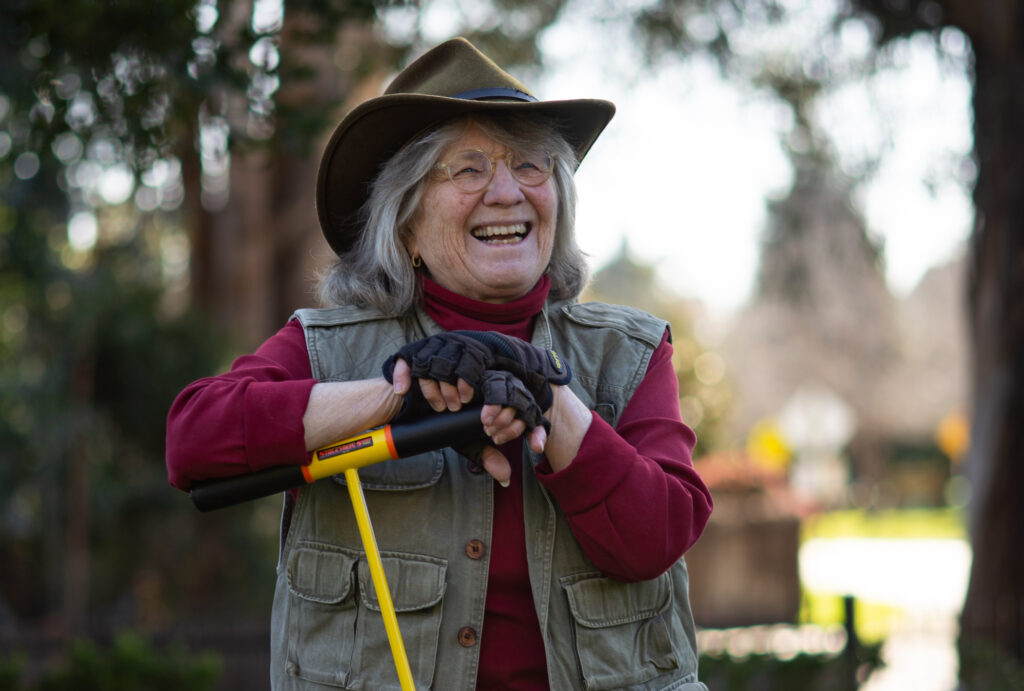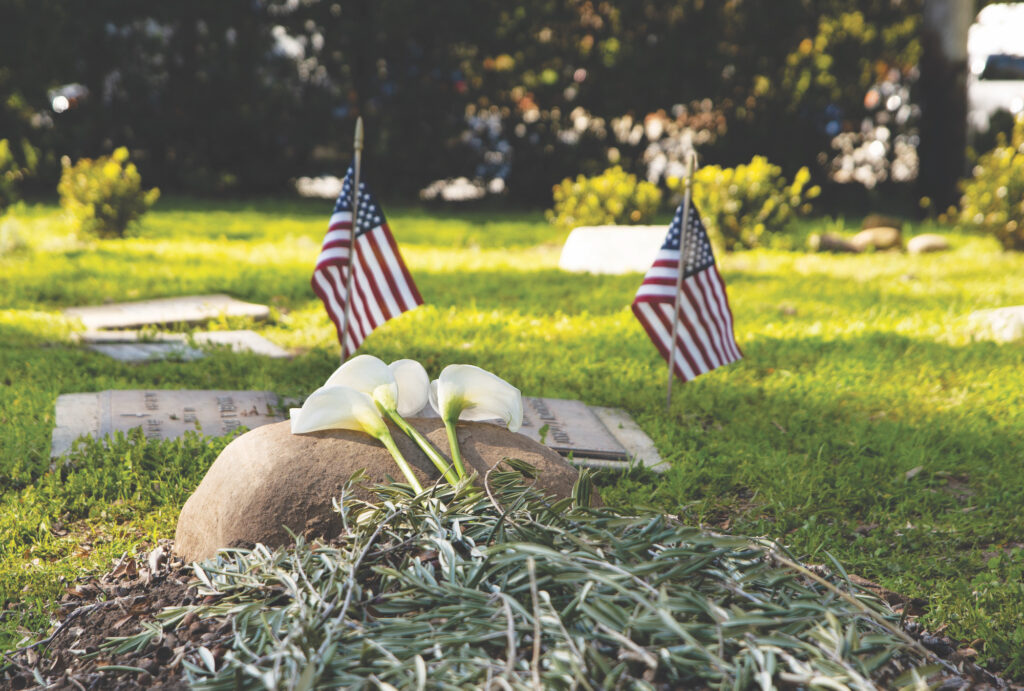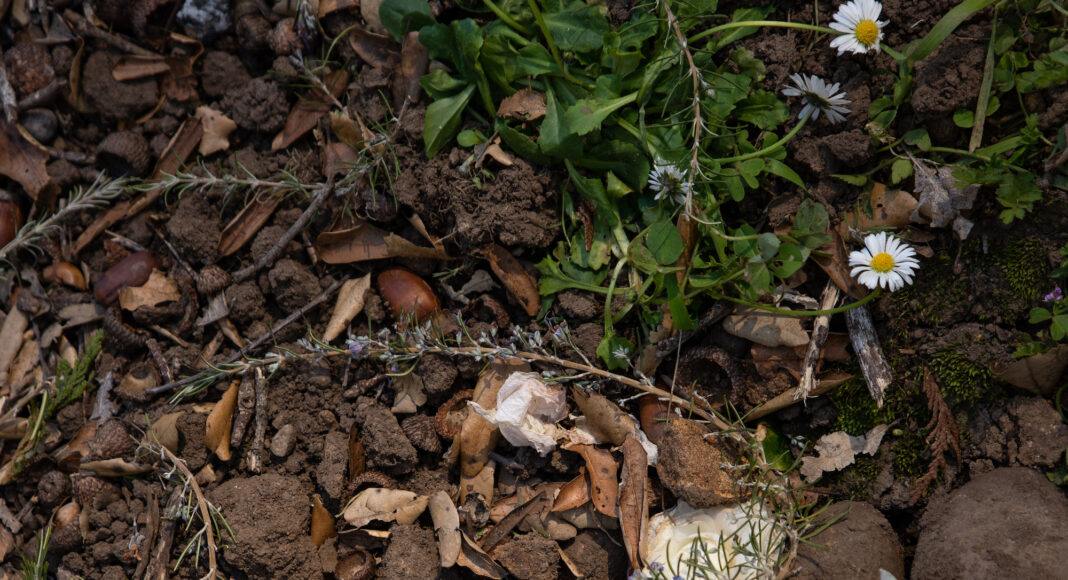The Sea Spirit—a 50-foot-long boat that hosts floating funerals—brings corpses from the Santa Cruz harbor to their final resting place, over three miles from shore and 600 feet below the sea’s surface. On this particular day, the 38-passenger vessel, previously used for whale-watching, is taking a group of people thinking about plans for the end of their own lives out onto the water.
Patricia Kimie, a funeral pre-planning specialist at Benito & Azzaro Funeral Home in Santa Cruz, hopes guests get a taste of what their funeral would look like. She uses the boat to host one of her seminars around Santa Cruz’s options for green burial, an environmentally-minded alternative to conventional burials and cremations.
91-year-old California transplant and ocean lover June Smith is happy to accept an invitation to explore her after-life options. In 2019, Smith wrote an opinion piece for Good Times about how she wanted a green burial after reading a 2011 article about the future of green burials in Santa Cruz. Now, she’s reconsidering her options after a cruise on the Sea Spirit.
“I feel like I’m a girl of the sea,” Smith says.
Being laid to rest at sea is just one of many options in Santa Cruz. With growing awareness of the negative environmental impacts of the funeral industry, many people are looking for a greener final act.
Now, there’s one more option in the works for California. Last September, Gov. Gavin Newsom signed AB351, adding a new method for returning bodies to the land to existing legislation. The process is called natural organic reduction, or “human composting,” which will be available in California in 2027. While there is some excitement surrounding the prospect of this earthy process, longtime green funeral industry advocates are arguing that the greenest age-old solutions are already legal across the country. Many can be found right here in Santa Cruz County.
“There’s an older and simpler solution that’s been overlooked—it’s just not sexy enough,” green burial advocate Lee Webster says.
Going into the ground can be more complicated than it sounds. In contemporary burials, an embalmed body is set inside a lacquered wood and metal casket and often interred in a plastic or cement vault, popularized in the early 1800s to prevent grave robbing. Coffins require immense resources, and manufacturing and embalming fluids and barriers don’t prevent bodies from decaying; they just inhibit nutrients from returning to the soil.
The two-to-three-hour process of incinerating a body down to “cremated remains” is employed for over half of deaths in the U.S. It’s the fastest and cheapest way to go. Without a cemetery plot or official service, the process costs $1,300 to $2,300 on average in California, compared to the $7,000 to $12,000 price tag for contemporary burials with vaults.
While it may be the cheapest route, the actual costs are environmental. The cremation process consumes fossil fuels and releases over 500 pounds of carbon emissions per person, about the same as driving 550 miles with an average car. Mercury and nitrous oxide are also released, causing air quality concerns. Then, when ashes are improperly spread, the highly alkaline remains can eat away at plant roots and change the pH of healthy soils.
“Cremation seemed like a really good idea,” says Holly Blue Hawkins, a green burial advocate at Soquel Cemetery and Temple Beth El in Santa Cruz. “But now that we know better, it’s time to shift.”
Human composting hopes to do just that; provide an eco-friendly alternative to cremation.
“People are interested in leaving a lasting legacy that does good for the earth,” says Haley Morris at Earth Funeral, a composting company in the Pacific Northwest.
While there are several different patented processes for human composting, they all follow a general framework.

Human Composting
Inside a futuristic-looking vessel about the size of a twin bed, layered mulch, alfalfa, straw and sawdust waits. A body cloaked in a simple cotton shroud is laid on top like an open casket. Loved ones may adorn the body with flowers and other biodegradable mementos.
Like a compost pile, the organic materials must be periodically rotated to provide oxygen to hard-working microbes. After four to eight weeks, the pod will be filled with “compost,” bones and any medical implants—like hip replacements. After bones are ground down and reincorporated into the compost, it’s tested for dangerous bacteria or heavy metals. Finally, one cubic yard of compost remains—over 10 standard wheelbarrows worth.
According to California state law, the same rules apply for spreading this human compost as we follow for cremated remains. In Santa Cruz, remains can be put in a cemetery, on your residence or someone else’s property with their permission, Kimie says. Urban human composting facilities also own conservation areas to use the soil for forest restoration. While the existing companies don’t have specific locations planned for facilities in California, they say it’s in the works.
“We don’t have precise plans for where or exactly when we will land in California yet,” Katrina Spade, founder of Recompose in Washington, the first human composting facility in the country, says. “But we worked hard to pass the California legislation, and it’s been our plan from the get-go to have a location—or two—there.”
Morris adds that Earth Funeral supports shifting the business to make human composting a mainstream option.
“We want to be available everywhere and accessible to anyone who wants it,” she says. “California is a big state, so we have to figure out a way to optimize our services.”
But current prices don’t beat the cost of cremation. Introductory package rates at the urban facilities range from $5,000 to $7,000, but some have community funds for regional residents unable to pay in full. Herland Forest, a no-frills solar-powered human composting site in Washington state, charges $3,000.
As companies expand into California and new ones open, it’s uncertain if prices will be affected. Some companies offer opportunities to lock in their current price, protecting clients from increases. Brianna Smith, CEO of the Seattle-based Return Home, doesn’t expect their prices to drop—she says the cost ensures proper care for staff is necessary. Kimie says her Santa Cruz County clientele are already writing human composting into their wills despite the cost.
Brad Angell, an architect and capital planner at UC Santa Cruz with a background in urban compost planning, says he’s wanted to be composted for decades.
“It just doesn’t grab my heart to think about being in a box and under the ground,” he says.
While enthusiasm grows locally, there are still some concerns. Lee Webster, a longtime leader in the green burial industry, points out that while the process is eco-minded and certainly greener than cremation and contemporary burials, it still involves a lot of resources and energy. Urban facilities must be built, requiring manufactured resources, and energy is used to keep these operations running 24/7. Alfalfa, a water-intensive plant grown in the water-conscious west, and other biomaterials must be grown, harvested, processed and transported to the facility. Finally, the resulting heaping compost truckload must be driven to its final resting place.
Webster also worries that spreading this compost in conservation areas could disrupt existing balances of nutrients and microbes that may ultimately hurt forests rather than help them. Human composting companies assured me they work with ecologists to care for the land where remains are incorporated.
“The plan was conceived out of a deep concern and deep respect for the environment,” she explains. “It’s just that the way to make it happen ended up not being as green as we had hoped.”
“We’re in the real baby steps here,” Webster says. “I love that California is going to wait five years.”
Billy Campbell, a physician and co-founder of Ramsey Creek Preserve, the oldest official conservation burial ground in the U.S., echoes Webster’s concerns regarding energy inputs and compost quality. He suggests that the concept could work well for specific ecosystems where bodies don’t decompose well—namely, dry soil in extremely hot or cold environments like the tundra or desert—unlike temperate Santa Cruz.
Spade says Recompose wants to provide an “ecological option” for city dwellers. However, Campbell and other opponents of the method argue that even as some companies grow their business, the month-plus process couldn’t replace quick cremations.
Smith says human composting “is the most natural way to go, second to putting you directly into a hole.” Longtime advocates are proposing just that.

Green Burials
Green burial generally refers to a less resource-intensive return that gives nutrients to the earth rather than harmful chemicals, as people have done across cultures since the beginning of humankind.
There is no cement vault, embalming fluid or industrial casket laden with lacquer and metals. While “green” burials can vary, they generally look like this:
An unembalmed body may be covered in a shroud and placed in a biodegradable casket ranging from pine to wicker to a cardboard-like substance or with no coffin. The body is lowered about three-and-a-half feet in the soil and surrounded by flowers and other organic materials. A favorite native tree or flower may be planted on top, and nature is left to take its course. Soil layers are then lovingly replaced.
Caitlin Hauke, an immunologist and the council’s president of education and outreach, assures me that chemicals leaching from contemporary burial practices are more of a concern than any pathogens from human bodies spreading into drinking water.
“When bodies are buried directly into the ground, they stay right there,” says Webster. “They don’t float around. They don’t go anywhere. All the microbes come to them to do all the work.”
Not only is it safe, but burying bodies naturally allows our death to bring about new life, returning nutrients to the soil. “If we’re going to look at this strictly from an environmental point of view,” says Webster, “body direct burial is still the thing that makes the most sense.”
While green burial sounds simple, the costs can vary as you still have to pay for a plot and associated fees. Along the Central Coast, plots—with their opening and closing fee—start around $5,000.
Unlike human composting and other means, green burials are legal everywhere. Individual cemeteries make the rules about what can and can’t go into the ground with a body, not the government.
Santa Cruz and the surrounding area are already home to many options for green burial.
Soquel Hybrid Cemetery
Both contemporary and green burials are welcome at Soquel Cemetery. It’s what the Green Burial Council calls a hybrid cemetery.
Holly Blue Hawkins, who serves the Chevra Kadish, a Jewish burial society at Temple Beth El, looks after Soquel Cemetery, which is owned by the temple. She takes care not only of those buried there but the land itself.
Temple Beth El has a reserved section for Jewish burials, which are inherently green, like Native American burial practices. Hawkins says over half the people who reach out to her are interested in green burial. While Hawkins is a big proponent of green burials, she provides contemporary full-body burials and cremation plots at Soquel. She hopes people will get creative with their requests for green burials, realizing they can personalize it just about however they want.
And she has big hopes for the future. “We can do it here in a very modest local way,” Hawkins says, but her dream is for Santa Cruz County to have a conservation cemetery, where bodies not only give back to the land but pay to protect it under a land trust.
Purissima Natural Cemetery
Kimie, who is helping Smith with her end-of-life plans, and her partner lie side by side in the dirt and look up at the sky. They turn to each other and laugh at the dark humor of their situation, lying on top of their future grave plots.
“It is our first and probably only ocean-view property we’ll ever own,” she jokes. “And way under a million.”
Kimie talks about the purple silk shroud and biodegradable willow casket she has her eye on like a teen getting to plan for prom. Her light attitude isn’t odd for Purissima, a once-abandoned cemetery from the 1860s in Half Moon Bay. Now, it thrives as what the council calls a “natural cemetery.” Here, only green burials are allowed. The five-and-a-half-acre property looks more like a place to hike than a rigid cemetery.
Smith had been set on the ocean-view plot at Purissima until she came across the Sea Spirit.
Burial at Sea
While all boat charters can technically spread cremated remains, Sea Spirit goes further, providing full body burial at sea as well. Miles off the coast—legally, at least three—unembalmed (and free of chemotherapy) bodies, shrouded with or without a biodegradable casket, are gently slid down a mahogany slide and guided feet first into the sea, where they will eventually rest on the ocean floor.
According to Webster, an “age-old” practice, sea burials are another form of returning the nutrients of one’s body to the earth, though it does take generous amounts of gasoline to power the 50-foot vessel.
Thanks to 150 pounds in rocks and the immense pressure at over 600 feet of water, bodies won’t come bobbing up to the surface or wash up on foreign shores, Raina Stoops, co-owner of the company, assures. Instead, nature will take its course, returning the body’s nutrients to the marine life below. At $4,800, it’s currently cheaper than most local green burial plots.
For Smith, a ride on the Sea Spirit was convincing. But she says she’s now leaning toward having her cremated remains scattered in the bay in view of her late husband’s memorial bench.
“I should do what feels right to me,” Smith explains. “Not what one of my kids says, or my neighbor.”
While Kimie advocates for green burial education and options, she says her ultimate role is to help people find the best plan for them. The number one concern end-of-life planners and service providers share is that people should have all the information to make informed choices before it burdens their families.
“If we don’t take care of this stuff, it’s really like the worst kind of littering,” Hawkins says. “Because we’re leaving a mess for people to clean up when they deserve the right to be mourning us.”














We need more cemeteries to allow green burials in Santa Cruz. Why aren’t there any? I may be mistaken, but I believe green burials are aligned with Jewish burial traditions, so I assume Jewish cemeteries allow for this. If so, that would imply that it’s not impossible, it’s just not being done by anyone else. Some people neither want to be composted nor embalmed or cremated, and there are almost no options for this type of burial in SC County, a place that likes to pride itself on its environmentalism. It’s very frustrating.
I always heard that it was illegal to spread ashes (cremains) in California. I am holding my daughters ashes and I feel as if there is no closure. Can I bury them on or 2 acre property?
I am only just reading this article today but saw your comment and wanted to reply, Roxann. The article, above, states that it is within state law to bury cremains on your own property or on someone else’s property with their permission.
“According to California state law, the same rules apply for spreading this human compost as we follow for cremated remains. In Santa Cruz, remains can be put in a cemetery, on your residence or someone else’s property with their permission, Kimie says.”
I hope that you find some solace and some peace with the burial of your daughter.